
(Additional content at flickr Photostream and YouTube Channel)
If you have botany questions or comments please email BobK . Thanks!
"Guvblitz," or "Is it
legal to have this much fun?"
Ohio Governor's Residence and Heritage Garden
August 28, 2010. Bexley, Franklin County, Ohio
Ohio Governor's Residence and Heritage Garden
August 28, 2010. Bexley, Franklin County, Ohio
What a pleasant surprise it
was when Rick Gardner asked me if I would participate in a "bio-blitz" at
the Ohio Governor's Residence. A bio-blitz is a science cum
educational activity where people who enjoy identifying living things
congregate at a some special natural area and tally as many species as
they can in a set amount of time. Why hold a bio-blitz at the
Governor's residence? Although the Governor's residence is somewhat
upscale, it's not excessively so. Nor is it on a huge plot of land,
occupying 3 acres in a fairly normal, upscale but not excessively so,
suburb of Columbus called Bexley.
We were greeted by then-Governor Ted Strickland, and former First Lady Hope Taft. Even though it was the thick of election season, this was a wonderfully non-partisan affair, as these are both super-nice people, relaxed and happy, and it was all about the bio-blitz with the young people there eager to learn about field biology, not politics.

Ted Strickland and Hope Taft greet young naturalists. August 28, 2010.
What's special about the this place nature-wise is the
Heritage
Garden. Designed to showcase the five principal biogeographic regions
in Ohio,
this awesome botanical display was established in 2000 under the
intitiative of then First
Lady Mrs. Hope Taft. Hope is keenly interested in native plants, and is
a
cheerful and articulate advocate for ecosystem preservation and the use
of wildlife-enhancing
plants in horticulture. She was on hand this day to lead tours of the
Garden to a contingent of interested young people from the Black Swamp
Bird
Observatory, based in northern Ohio.

Hope Taft leads tour at Heritage Garden during bio-blitz. August 28, 2010.
We were greeted by then-Governor Ted Strickland, and former First Lady Hope Taft. Even though it was the thick of election season, this was a wonderfully non-partisan affair, as these are both super-nice people, relaxed and happy, and it was all about the bio-blitz with the young people there eager to learn about field biology, not politics.

Ted Strickland and Hope Taft greet young naturalists. August 28, 2010.

Hope Taft leads tour at Heritage Garden during bio-blitz. August 28, 2010.
The
five physiographic regions re-created here are: (1) glaciated Allegheny
Plateau of northeastern Ohio (including cranberry bog!); (2)
Appalachian region (including cedar glade!!), (3) Huron-Erie Lake Plain
(including sand dune!!!), (4) Lake Erie Alvar (including limestone slab
with glacial grooves!!!!), and (5) Central Lowland Till Plains
(prairie!!!!!).
My job was to find and identify mosses. Here are two of them, hanging out with a cranberry in the bog. The large one in the center is some species of Sphagnum that I could only guess at, and on the left is Aulocomnium palustre.

Cranberry and friends at bog in Heritage Garden. August 28, 2010.
My job was to find and identify mosses. Here are two of them, hanging out with a cranberry in the bog. The large one in the center is some species of Sphagnum that I could only guess at, and on the left is Aulocomnium palustre.

Cranberry and friends at bog in Heritage Garden. August 28, 2010.
At
this time of the year, prairie is the most striking plant
community. Here it's being inspected by Guy Denny, a retired Chief of
the ODNR Division of Natural Areas and Preserves, and a co-founder of
the Heritage Garden.
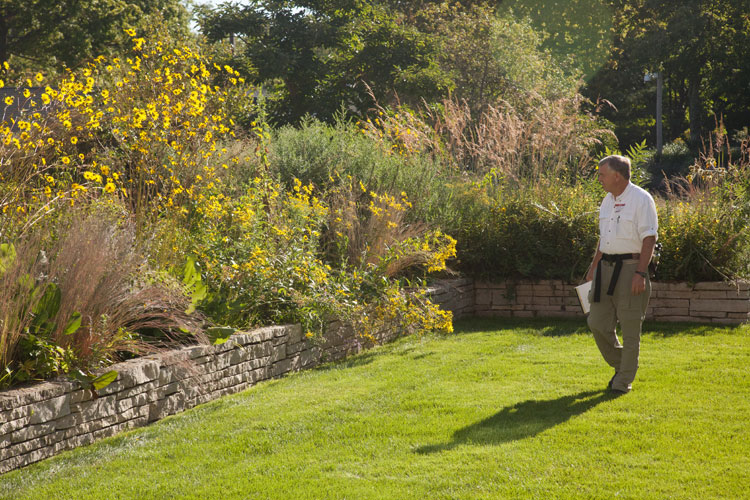

Guy Denny at Prairie
Heritage Garden. August 28, 2010.
One of the plants featured
here is ashy sunflower, Helianthus
mollis
(Asteraceae). At the northeastern edge of its range, this prairie
perennial is known from only a handful of Ohio counties. The
combination of dense gray pubescence and clasping leaves is
distinctive.

Ashy sunflower at Heritage Garden. August 28, 2010.

Ashy sunflower at Heritage Garden. August 28, 2010.
Because they are large,
spreading, and have a fidelity to undisturbed open areas, the
"signature" prairie wildflowers are members of the genus Silphium (rosin-weed, prairie dock,
and compass-plant) in the Asteraceae (sunflower family). This one,
compass plant, S. laciniatum,
is a western species for which there is only one known natural (possibly natural is more accurate)
Ohio occurence, in Lawrence County (at the extreme southern tip of the
state). Compass-plant does
well in cultivation, however, and is a terrific addition to a prairie
garden.

Compass-plant at the Heritage Garden. August 28, 2010.

Compass-plant at the Heritage Garden. August 28, 2010.
Another conspicuous genus in
the Asteraceae with a fidelity to prairies is Liatris, the blazing-stars, of
which 5 species occur naturally in Ohio. This one is rough
blazing-star, L. aspera.
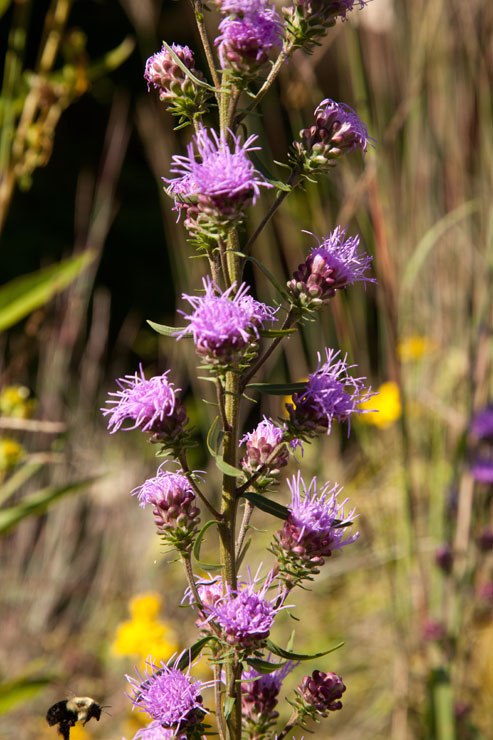
Rough blazing-star at Heritage Garden. August 28, 2010.

Rough blazing-star at Heritage Garden. August 28, 2010.
Blazing-star identification
can be a bit tricky. It depends, in
part, upon a close examination of the phyllaries, i.e., involucral
btacts --those little leaf-like appendages that are spirally arranged
on the lower portion of each flower head. The bracts of L. aspersa have
a broad uneven irregularly lacerate scarious (papery) border. Here's a
zoom-crop of a flower head from the photo above, showing the scarious
border of the involucral bracts.
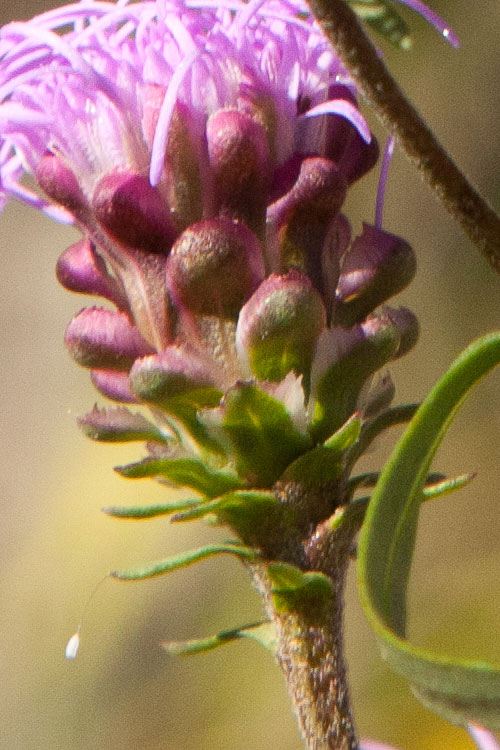

The legume (pulse) family,
Fabaceae, is also among those most well represented in prairies.
Partridge-pea, Chamaecrista
fasciculata
is a showy annual in the subfamily Caesalpinoideae, a
primarily tropical group distinguished from the more typical
"papilionoid" legumes (subfamily Faboideae) by having flowers with the
upper petal (the "standard") innermost instead of outermost, and the
stamens usually separate from one another instead of being fused in
some manner.
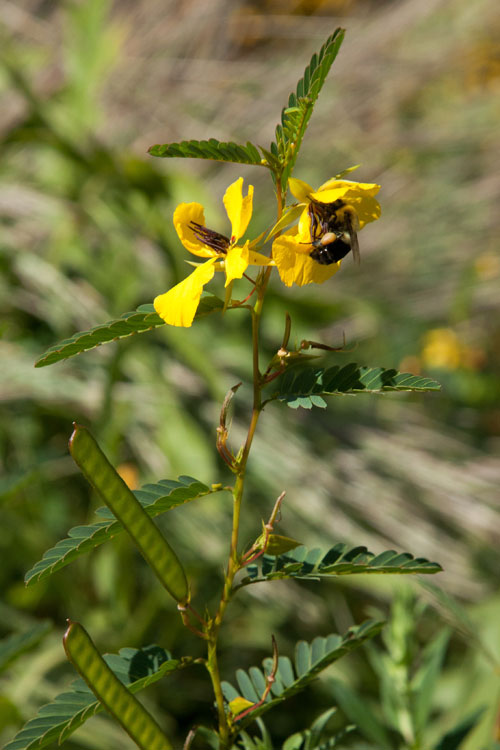
Partridge-pea in the Heritage Garden. August 28, 2010.

Partridge-pea in the Heritage Garden. August 28, 2010.
Here's my tally of the
bryophytes:
Campylium chrysophyllum, Funaria hygrometrica, and Tortella tortuosa.
Fissidens dubius and Rhodobyrum ontariense.
Amblystegium varium, Anomodon attenuatus, Desmatodon obtusifolius, Hyophila involuta, and Plagiomnium cuspidatum.
Aulacomnium palustre, and Sphagnum sp.
Amblystegium varium, Bryum argenteum, Bryum lisae var. cuspidatum, Entodon seductrix, Fissidens taxifolius, Frullania eboracensis, Leptobryum pyriforme, Leskea gracilescens, Orthotrichum pusillum, Physcomitrium pyriforme, Platygyrium repens, Pohlia sp.and Tortula papillosa.
Learn more about the Heritage Gardens HERE.
Bryophyte List from the
Heritage Gardens Bioblitz
August 28, 2010 (Bob Klips)
August 28, 2010 (Bob Klips)
Kelly’s Island Garden
Campylium chrysophyllum, Funaria hygrometrica, and Tortella tortuosa.
Dolomites Rocks (Edge of
Appalachia) Garden
Fissidens dubius and Rhodobyrum ontariense.
Sandstone Boulder near
Greenhouse
Bryum capillare, Desmatodon
obtusifolius, and Schistidium
rivulare.Allegheny Plateau Garden
Amblystegium varium, Anomodon attenuatus, Desmatodon obtusifolius, Hyophila involuta, and Plagiomnium cuspidatum.
Cranberry
Bog Garden
Aulacomnium palustre, and Sphagnum sp.
General Grounds
Amblystegium varium, Bryum argenteum, Bryum lisae var. cuspidatum, Entodon seductrix, Fissidens taxifolius, Frullania eboracensis, Leptobryum pyriforme, Leskea gracilescens, Orthotrichum pusillum, Physcomitrium pyriforme, Platygyrium repens, Pohlia sp.and Tortula papillosa.
Learn more about the Heritage Gardens HERE.
Insects Forage on
American Fireweed
(Erechtites hieracifolia)
August 27, 2010. Marion County, Ohio.
(Erechtites hieracifolia)
August 27, 2010. Marion County, Ohio.
It's harvest time for Team
Milkweed --harvesting data,
that is, and while tallying fruit-set on the hand-pollinated and
open-pollinated control plants at Killdeer Plains Wildlife Area, it
is a pleasure to see some late-summer insects enjoying life among the
follicles. This is, I believe, a fork-tailed bush katydid, Scudderia furcata, an orthopteran
that can be found in brushy areas across all of the lower 48 states.
This specimen is a female --note the upwardly curved ovipositor. (The forked "tail" in its name refers to the male's bifurcated dorsal processes.)
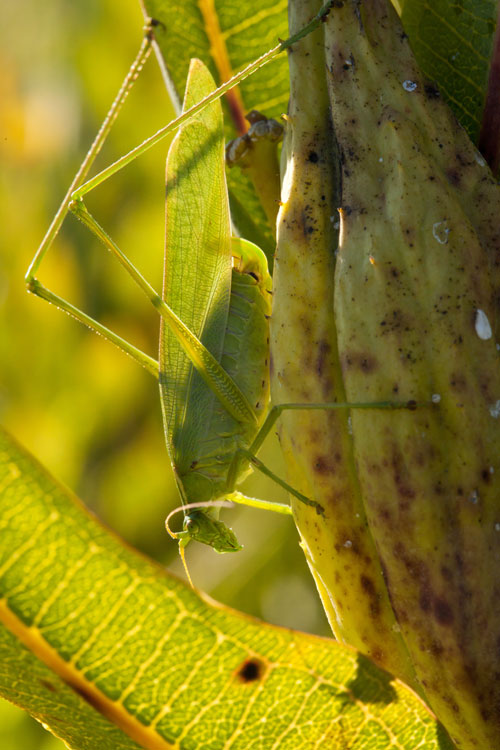
Fork-tailed bush katydid on Sullivant's Milkweed. August 27, 2010.
This specimen is a female --note the upwardly curved ovipositor. (The forked "tail" in its name refers to the male's bifurcated dorsal processes.)

Fork-tailed bush katydid on Sullivant's Milkweed. August 27, 2010.
American fireweed, Erechtites hieracifolia (Asteraceae,
the daisy familu),
an is interesting plant that, like its fellow "composites" ragweed and
horseweed, is a somewhat weedy native annual deserving of way more
respect that it usually gets. (This is not the fireweed that is a showy
wildlflower in the
evening-primrose family), .
The bush katydid seems to like it, too.
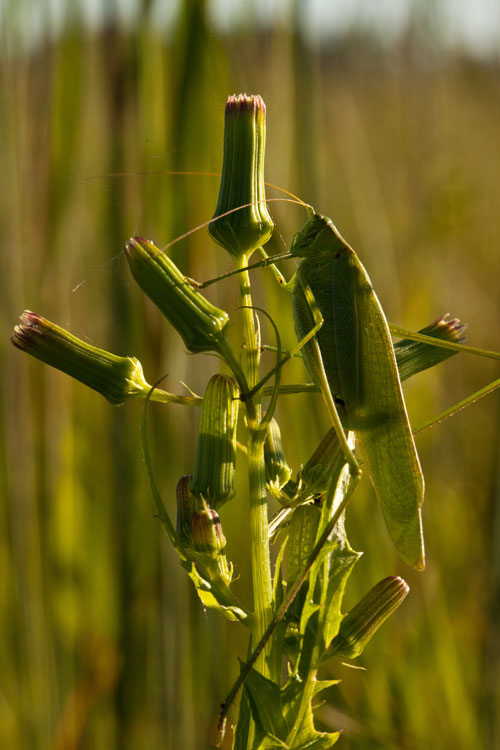
American fireweed with bush katydid. August 27, 2010.
Killdeer Plains Wildlife Area, Marion County, Ohio.
This common plant of open areas has a "discoid" capitulum type, i.e., its flower heads are composed only of radially symmetric flowers. The petal-simulating strap-shaped "ray" flowers that are found at the periphery of the heads of many other members of this family are lacking here. Accordingly, this species gives the appearance of being self-pollinated, and indeed it probably is, at least principally. It is intriguing to see two species of insect merrily nectaring on the pathetic fireweed flower heads.
This is a honeybee.
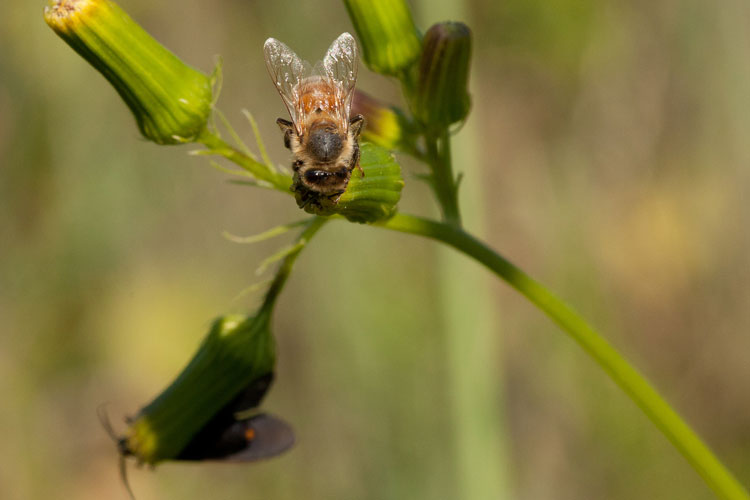
Honeybee forages on fireweed at Killdeer. August 27, 2010.

American fireweed with bush katydid. August 27, 2010.
Killdeer Plains Wildlife Area, Marion County, Ohio.
This common plant of open areas has a "discoid" capitulum type, i.e., its flower heads are composed only of radially symmetric flowers. The petal-simulating strap-shaped "ray" flowers that are found at the periphery of the heads of many other members of this family are lacking here. Accordingly, this species gives the appearance of being self-pollinated, and indeed it probably is, at least principally. It is intriguing to see two species of insect merrily nectaring on the pathetic fireweed flower heads.
This is a honeybee.

Honeybee forages on fireweed at Killdeer. August 27, 2010.
...and this is a delightful
day-flying moth, Virginia ctenucha, Ctenucha
virginica (Arctiidiae), a common species endemic to eastern
North America.
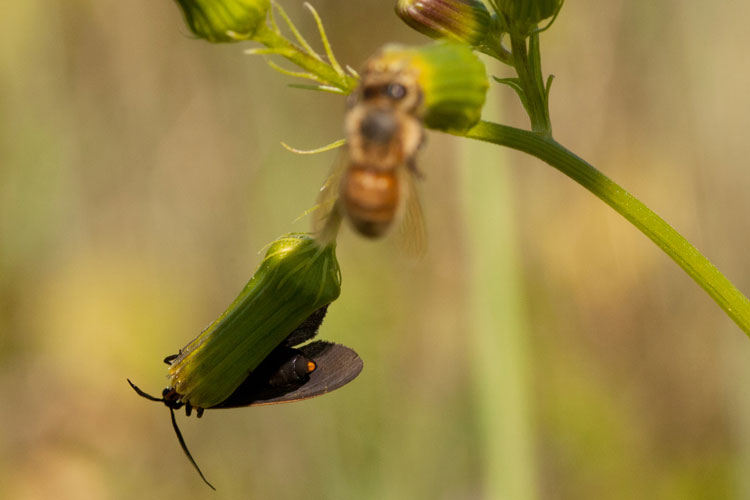
Virginia ctenucha on American fireweed at Killdeer. August 27, 2010.

Virginia ctenucha on American fireweed at Killdeer. August 27, 2010.
It's always fun to see
different members of a genus co-habiting an area. In this case, they
are weedy foxtail grasses. The larger of the two seemd to be giant
foxtail, Setaria faberii
(Poaceae, the grass family).
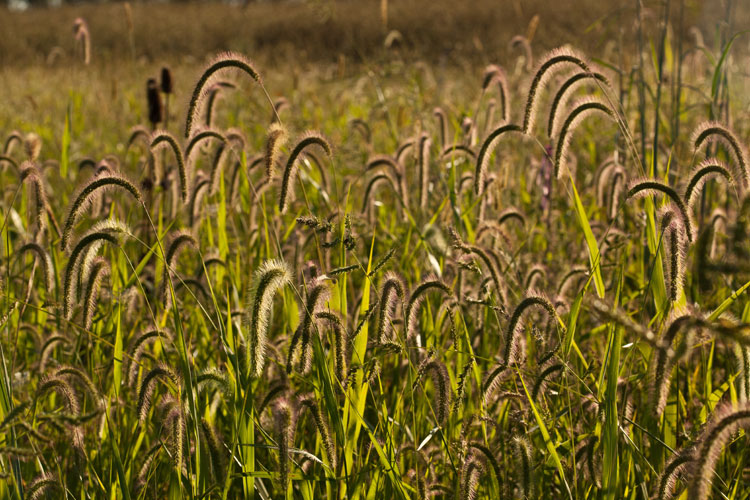
Giant foxtail grass at Killdeer Plains. August 27, 2010.

Giant foxtail grass at Killdeer Plains. August 27, 2010.
The giant foxtail is larger
than other foxtail species, and its spikes droop dramatically. Along
with this giant one is a smaller, more erect-spiked species that seems
to be yellow foxtail grass, Setaria
glauca. Here are the two of them, side-by-side.
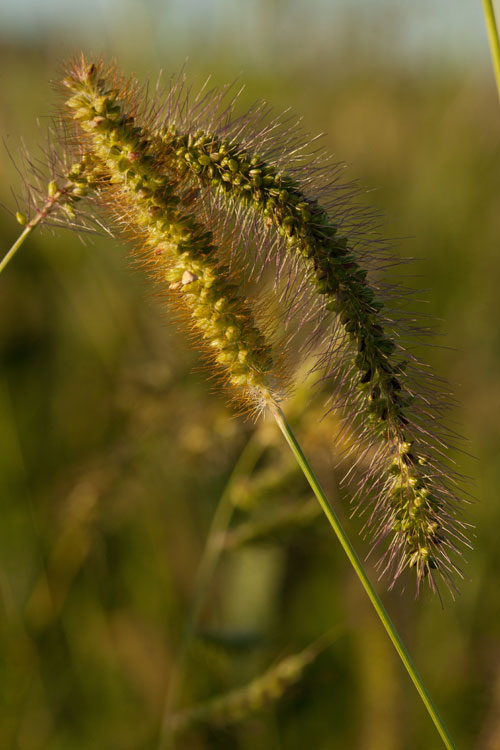
Setaria times two at Killdeer. August 27, 2010.

Setaria times two at Killdeer. August 27, 2010.
Another awesome orthopteran
is evident in this meadow. Abundant and conspicuous at least via the
auditory route as the males are constantly singing with a loud
continuous trill, it's black-horned tree cricket, Oecanthus nigricornis. The specimen
shown below is a female. (Note the ovipositor.)
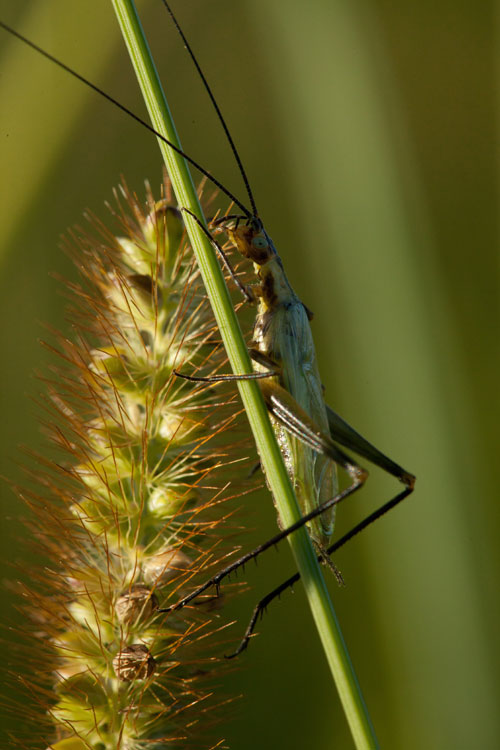
Black-horned tree cricket. August 27, 2010.

Black-horned tree cricket. August 27, 2010.
Almost Androdioecous
Virgin's-bower (Clematis virginiana)
August 21, 2010. Hocking County, Ohio
Virgin's-bower (Clematis virginiana)
August 21, 2010. Hocking County, Ohio
On our way to a work weekend,
or maybe it was a party (is there a difference?) at Deep Woods, a
privately owned nature preserve in Hocking County, we were impressed by
the beautiful riot of late summer wildflowers along the road.

Roadside wildflowers. August 21, 2010. Hocking County, Ohio.

Roadside wildflowers. August 21, 2010. Hocking County, Ohio.
One of the plants here --the
white flowered one in the photo above--is virgin's-bower, Clematis virginiana. Inasmuch
as its family, Ranunculaceae (the buttercup fam.) is composed mainly of
alternate-leaved herbs with hermaphroditic flowers, this genus is a bit
of a standout by virtue of its opposite leaves, woody habit, and mating
system that includes unisexual flowers.
These are the flowers on the wholly staminate (male) individuals. Note that there is a fine functional androecium of pollen-producing stamens, but no ovule (seed)/carpel (fruit)-producing parts whatsoever. (Side note: the white petal-like appendages, 4 per flower, are actually sepals; these flowers happen to be petel-less.)
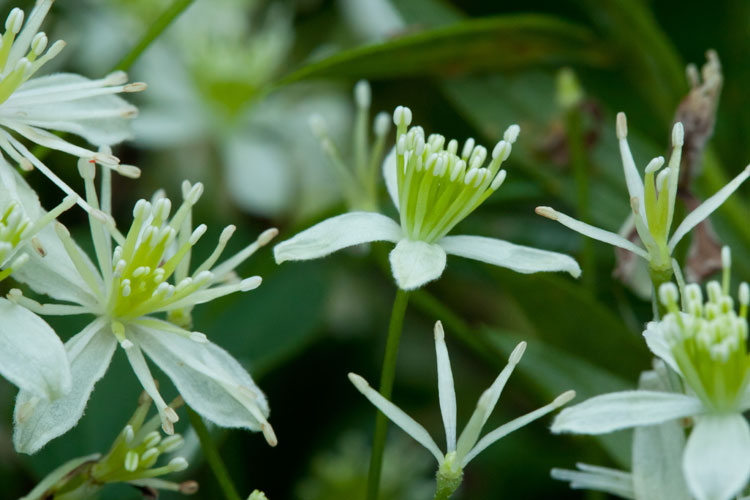
Male Clematis virginiana flowers. August 21, 2010. Hocking County, Ohio
Here's another Clematis individual.

Clematis virginiana is a dioecious opposite-leaved woody vine.
August 21, 2010. Hocking County, Ohio.
These are the flowers on the wholly staminate (male) individuals. Note that there is a fine functional androecium of pollen-producing stamens, but no ovule (seed)/carpel (fruit)-producing parts whatsoever. (Side note: the white petal-like appendages, 4 per flower, are actually sepals; these flowers happen to be petel-less.)

Male Clematis virginiana flowers. August 21, 2010. Hocking County, Ohio
Here's another Clematis individual.

Clematis virginiana is a dioecious opposite-leaved woody vine.
August 21, 2010. Hocking County, Ohio.
The plant shown above is
female. Here's a close-up of her flowers. In the center of each, see a
large number of pollen-receptive styles --the upper part of the female
gynoecium --protruding above the other
parts. Other parts? What other parts? Yes, those seem to be stamens. If
these were functional pollen-producing stamens, then this population
would be "andodioecious," i.e., with both hermaphrodites and
wholly/solely
male individuals. But because the path to dioecy (separate male and
female individuals) generally involves male sterility caused by
so-called "cytoplasmic" factors, i.e., mitochondrial genes that are
passed along only through the female line, the transmission of those
genes is
enhanced by the total suppression of male sexuality, thereby directing
all of a plant's reproductive down the (mitochonria-carrying) female
line. Thus androdioecy, wherein females retain some male function, is a
spectacularly uncommon sexual condition. Alas, even though it looks
like this might be an example of androdioecy, it isn't. According to
published descriptions of Clematis
sexuality, these stamens are non-functional and these flowers, although
they don't look like it, are in fact wholly/solely female.
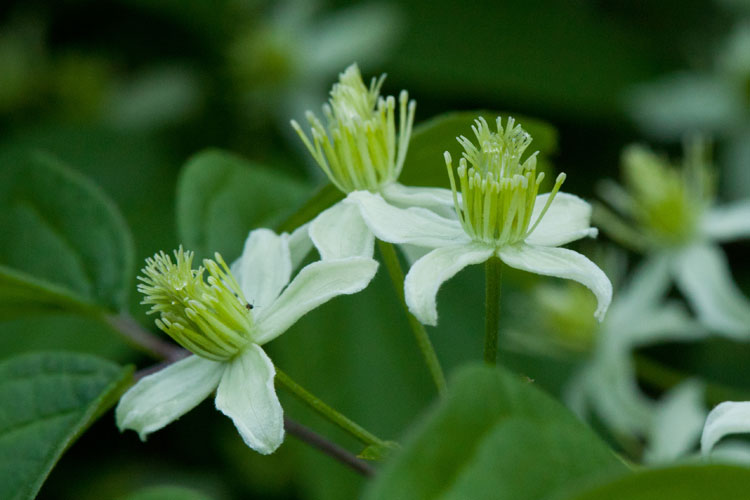
Not quite hermaphroditic flowers of virgin's-bower. August 21, 2010. Hocking County, Ohio.

Not quite hermaphroditic flowers of virgin's-bower. August 21, 2010. Hocking County, Ohio.
These funtionally female
plants are conspicuous well into winter, as their abundant clusters of
dry one-seeded fruits, each tipped by the feathery persistent style,
delightfully festoon roadside shrubbery, reminding everyone of a
virgin's bower, whatever the heck that is. An even more odd common
names is "devil's darnoing-needle."
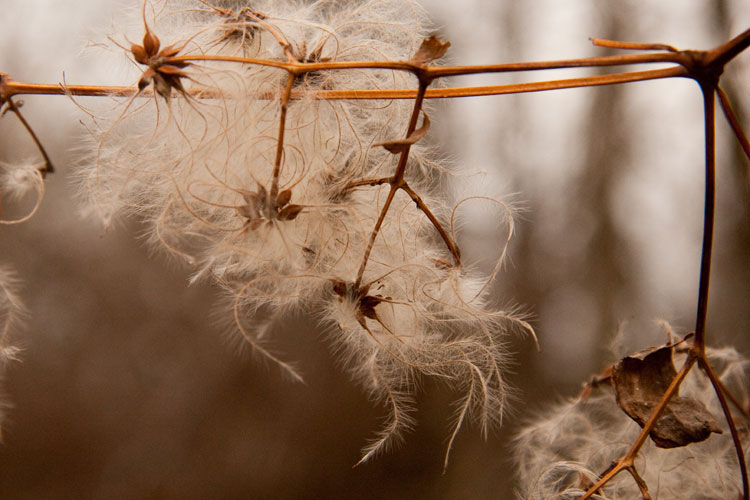
Virgin's-bower is distinctive in late fall and winter.
December 14, 2008. Delaware County, Ohio.

Virgin's-bower is distinctive in late fall and winter.
December 14, 2008. Delaware County, Ohio.
Also present in the meadow is
hollow Joe-Pye Weed, Eupatorium
fistulosum
(Asteraceae). The common name is said to be in attribution to a native
American herb doctor so-named, who used a member of this genus to treat
typhus.
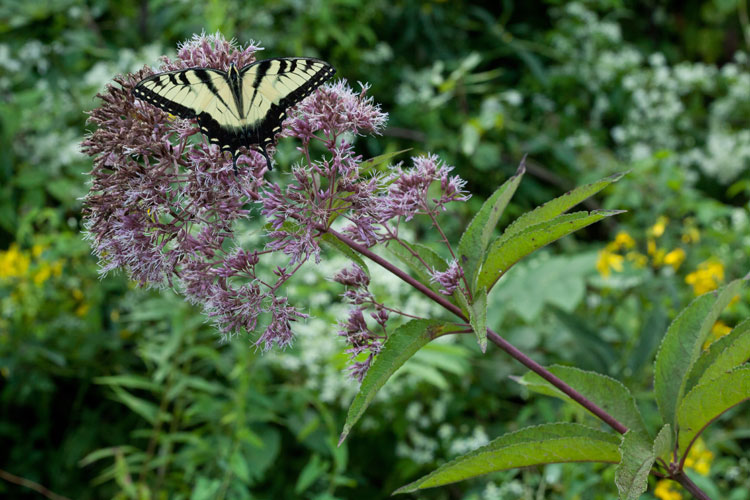
Hollow Joe Pye Weed in Hocking County, Ohio, August 21, 2010.

Hollow Joe Pye Weed in Hocking County, Ohio, August 21, 2010.
Time-traveling Tube
Ferns Paleozoic Swamp Forest
Mini-Replica
Waldo, Marion County, Ohio
Various summer evenings, mostly during August, 2011
Waldo, Marion County, Ohio
Various summer evenings, mostly during August, 2011
During the (aptly
named,
because it is when coal-beds were formed) Carboniferous
Period of the Paleozoic Era (approx. 350 to 299 million
years ago) there were vast swamps. The dominant vegetation in these
ancient swamps were "tree" versions of seedless vascular plants that
included a few general types that are still with us --ferns and
lycopods (clubmosses) --but which today are paltry low-growing remnants
of their former selves now that conifers and flowering plants are the
superstars of the plant world.
One of the dominant Paleozoic plants was Calamites, a jointed tubular form much like today's Equisetum, only much bigger. When we see dense stands of Equisetum, it's fun to imagine what the coal-swamps must have looked like. There's just such a spot in Waldo, Marion County, Ohio where there's an awesome little replica of a Paleozoic swamp forest.
Here's a picture of how flooded the spot sometimes gets. Usually there is no standing water here at all.

A wet spot in Ohio where Equisetum grows.
March 9, 2011.
One of the dominant Paleozoic plants was Calamites, a jointed tubular form much like today's Equisetum, only much bigger. When we see dense stands of Equisetum, it's fun to imagine what the coal-swamps must have looked like. There's just such a spot in Waldo, Marion County, Ohio where there's an awesome little replica of a Paleozoic swamp forest.
Here's a picture of how flooded the spot sometimes gets. Usually there is no standing water here at all.

A wet spot in Ohio where Equisetum grows.
March 9, 2011.
...and here's a
view from a
few years ago, looking up

Equisetum stand looking like a Calamites swamp forest.
April 26, 2006. Waldo, Marion County, Ohio.

Equisetum stand looking like a Calamites swamp forest.
April 26, 2006. Waldo, Marion County, Ohio.
Traditionally, Equisetum was placed in its very
own Division, Equisetophyta, separate from both the ferns
(Pterophyta) and the "lycophytes" (clubmosses, spikemosses and
quillworts, in the Division Lycophyta). There are two general growth
forms in Equisetum. The
branched species
are generally called "horsetails," and the simple tubular ones
like those featured here are called "scouring rush." However, now
that they're classified as pterophytes, a new name is sweeping the land
--they're called "TUBE FERNS!!"
This particular species is Equisetum hyemale, so-named because it is evergreen ("hyemale" means "of the winter"). Here's a picture of it during two extremes of the year.
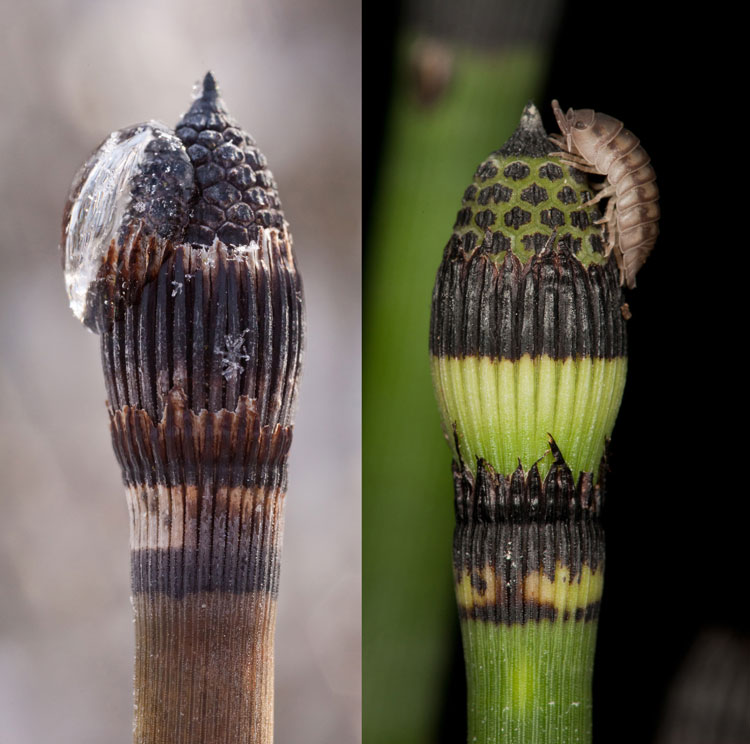
Equisetum hyemale at two seasons.
Left: February 11, 2011 with ice.
Right: August 17, 2010, with Armadillidium nasatum, an introduced isopod crustacean pillbug
Take an umbrella and glue a dozen jumbo bags of popcorn side-by-side along its six edges, and you've made a giant model of an Equisetum "sporangiophore." The popcorn bags represent sporangia filled with spores. Next, take a few dozen of those umbella contraptions and glue them to a flag-pole, arranged in a tight cone-like spiral, and call it an Equisetum "strobilus." Here's what it looks like in real life (Equisetum, not the crazy umbrella popcorn flag-pole contraption).

Equisetum strobilus is a spiral array of peltate sporangiophores.
This summer I got a new piece of macro photography gear: the Canon MT-24 twin flash, that has an excellent feature very helpful for taking pictures at night. Its accessory lamp which casts a little light on the subject to allow composing and focusing is actuated not only by a hard to reach button on the unit, but (yippee!) also by a convenient half-press of the shutter button. That makes hunting for bugs on Equisetum plants great fun. Plus, since the Carboniferous is also famous for having big arthropods, this adds to the "time travel" illusion.
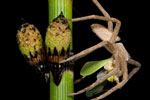



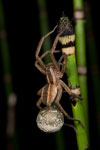
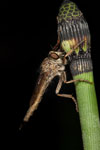
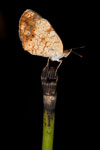
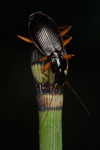
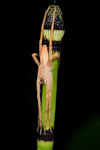
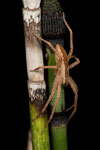
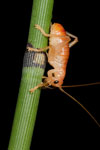

Here's a couple other critters that didn't make it into the Equisetum photo gallery because they're on grasses. One of the grasses is Virginia wild-rye, Elymus virginica, a very common native grass of wooded bottomlands that the short-winged meadow katydid seems to like.
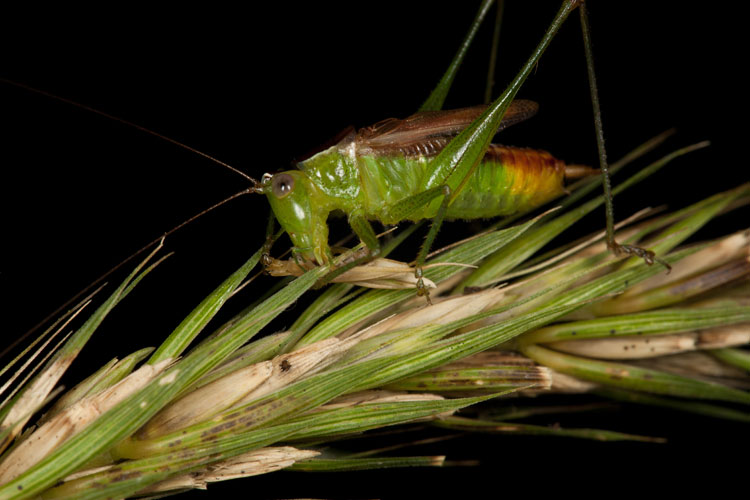
This particular species is Equisetum hyemale, so-named because it is evergreen ("hyemale" means "of the winter"). Here's a picture of it during two extremes of the year.

Equisetum hyemale at two seasons.
Left: February 11, 2011 with ice.
Right: August 17, 2010, with Armadillidium nasatum, an introduced isopod crustacean pillbug
Take an umbrella and glue a dozen jumbo bags of popcorn side-by-side along its six edges, and you've made a giant model of an Equisetum "sporangiophore." The popcorn bags represent sporangia filled with spores. Next, take a few dozen of those umbella contraptions and glue them to a flag-pole, arranged in a tight cone-like spiral, and call it an Equisetum "strobilus." Here's what it looks like in real life (Equisetum, not the crazy umbrella popcorn flag-pole contraption).

Equisetum strobilus is a spiral array of peltate sporangiophores.
This summer I got a new piece of macro photography gear: the Canon MT-24 twin flash, that has an excellent feature very helpful for taking pictures at night. Its accessory lamp which casts a little light on the subject to allow composing and focusing is actuated not only by a hard to reach button on the unit, but (yippee!) also by a convenient half-press of the shutter button. That makes hunting for bugs on Equisetum plants great fun. Plus, since the Carboniferous is also famous for having big arthropods, this adds to the "time travel" illusion.
TUBE-FERN
CRITTERS PHOTO GALLERY
-----Click to Enlarge-----
(Warning to arachniphobes...there's scary SPIDERS here!!)
-----Click to Enlarge-----
(Warning to arachniphobes...there's scary SPIDERS here!!)












Here's a couple other critters that didn't make it into the Equisetum photo gallery because they're on grasses. One of the grasses is Virginia wild-rye, Elymus virginica, a very common native grass of wooded bottomlands that the short-winged meadow katydid seems to like.

Short-winged
meadow katydid
munches on a wild-rye spikelet.
August 12, 2010. Waldo, Marion County, Ohio.
August 12, 2010. Waldo, Marion County, Ohio.
"Look Ma, no hands!"

Short-winged meadow katydid that wants to run away and join the circus.
Creeping bent grass, Agrostis stolonifera, with a broad-winged tree-cricket, Oecanthus latipennis.
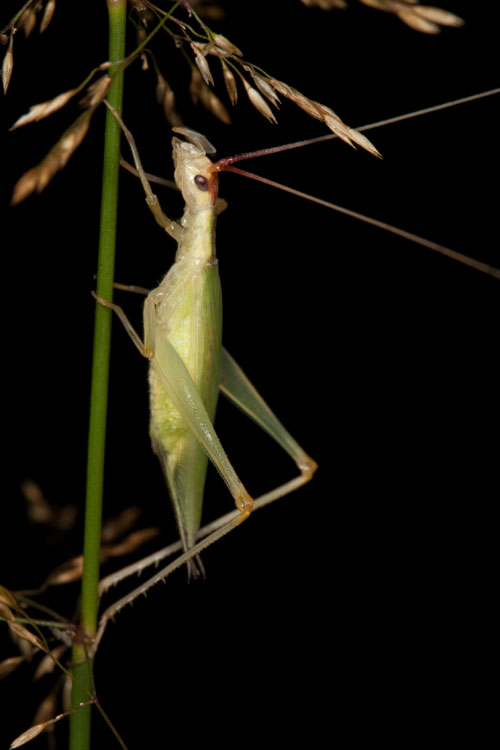
Broad-winged tree-cricket clutching bent grass culm.
August 12, 2010. Waldo, Marion County, Ohio.

Short-winged meadow katydid that wants to run away and join the circus.
Creeping bent grass, Agrostis stolonifera, with a broad-winged tree-cricket, Oecanthus latipennis.

Broad-winged tree-cricket clutching bent grass culm.
August 12, 2010. Waldo, Marion County, Ohio.

